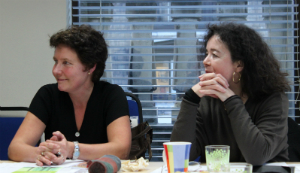This question has bothered me since I started as a social services research officer in 1992. Attending the NIHR School for Social Care Research (SSCR) Workshop: Maximising Research Impact in Adult Social Care last week was a chance to ponder this question and, more usefully, to hear other people’s ponderings. The event was very well attended, with a mix of academic (including Jo Moriarty, Jess Harris and me from the Social Care Workforce Research Unit) and local authority staff, with a small number of people who use services and carers. First up was a panel discussion, in which Martin Webber (York University); (Chris Rainey (West Sussex Social Services Research); and Deborah Rutter (Social Care Institute for Excellence – SCIE) gave short introductory accounts, followed by a long question and answer session. Three presentations followed: Sarah Carr (SCIE) emphasised the roles of service users and carers; George Julian (Research in Practice for Adults) gave some practical aspects using research evidence; and Jonathan Grant and Molly Morgan Jones (RAND Europe) presented various approaches to measuring research impact in social care.
Naturally, in the presentations and discussions, there was a sense of frustration about apparent lack of change over the years. Best metaphor of the day was from the Unit’s own Jess Harris, talking about the need to ‘bite people on the bottom’ when trying to encourage the use of research in policy. These feelings are understandable, the issues and barriers raised by all speakers – time, resources, attitudes of practitioners, managers and policy makers, levels of training, understanding of research methods, lack of good quality research presented in easy to understand formats, seem to have been around during my whole career as a researcher.
More positively, there was a welcome emphasis on dialogue and engagement of different stakeholders. This is valuable as there has often been a somewhat mechanical view of research evidence as a lever to change practice. This simplistic approach ignores important contextual factors, such as practitioners’ low level of discretion, making the direct application of research problematic. A focus on the need for dialogue and engagement, together with the idea of co-production, suggests an acceptance of the complexity of linking research evidence with policy and practice change.
However, I was left with three questions that need more attention in order to optimise the impact of research in policy and practice:
- What is the most appropriate and proportionate impact we can expect from research compared to that from other influences (politics, values, professional and user knowledge), given the necessary uncertainty and contestability of research evidence in this sphere?
- How should different kinds of evidence, which often arise from different assumptions about the nature of social world, be combined to make changes in policy and practice?
- How can policy making be changed in order to make best use of research (in terms of timescales, but also increasing the influence of people using services, carers, practitioners and researchers)?
Dr Martin Stevens is Research Fellow at the Social Care Workforce Research Unit at King’s College London. With Jess Harris he is currently writing the final report for the evaluation of Jobs First (an initiative encouraging the employment of people with learning disabilities) for the Department of Health. He is also Principal Investigator in a study examining the vetting and barring of workers in the sector.






